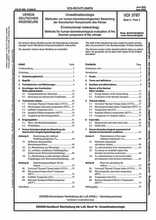Standards Worldwide
Standards Worldwide
Phone +49 30 58885700-07

Technical rule [CURRENT]
VDI 3787 Blatt 2:2022-06
Environmental meteorology - Methods for human-biometeorological evaluation of the thermal component of the climate
- German title
- Umweltmeteorologie - Methoden zur human-biometeorologischen Bewertung der thermischen Komponente des Klimas
- Publication date
- 2022-06
- Original language
- German, English
- Pages
- 80
- Publication date
- 2022-06
- Original language
- German, English
- Pages
- 80
Product information on this site:
Quick delivery via download or delivery service
Buy securely with a credit card or pay upon receipt of invoice
All transactions are encrypted
Short description
The health, well-being and performance of people are closely linked to the thermal environmental conditions via their heat balance. The importance of this topic for prevention planning is therefore evident. Affected are urban and regional planning as well as building design, public health, tourism and rehabilitation, weather forecasting, climate impact research, and others. Due to the importance of this problem, methods are described in this standard which describe the complex thermal environmental conditions in a thermophysiologically relevant way and which can be assessed on the basis of the human heat balance. This enables spatial and temporal assessments.
Content
ICS
07.060,
13.040.01
Replacement amendments
This document replaces VDI 3787 Blatt 2:2008-11 .
Also available in
Loading recommended items...
Loading recommended items...
Loading recommended items...
Loading recommended items...
